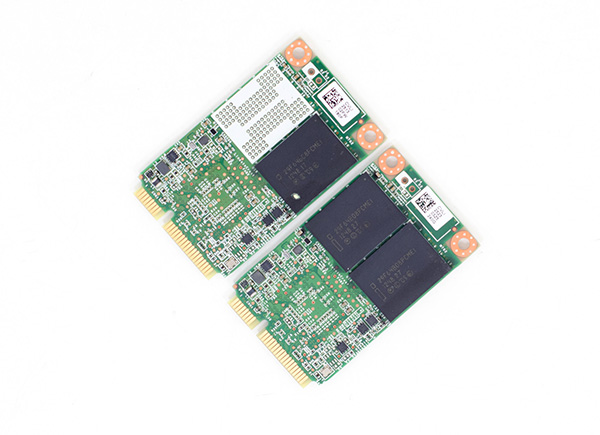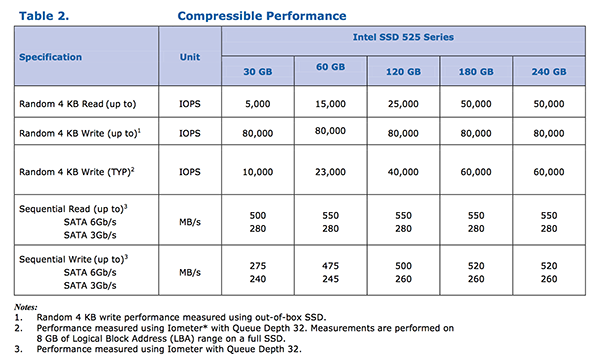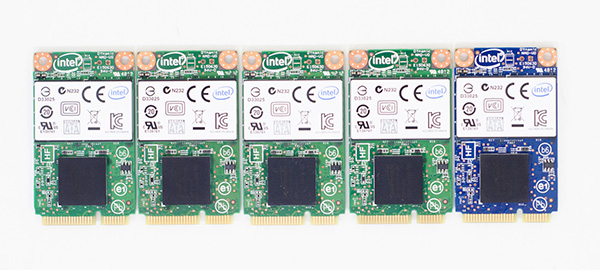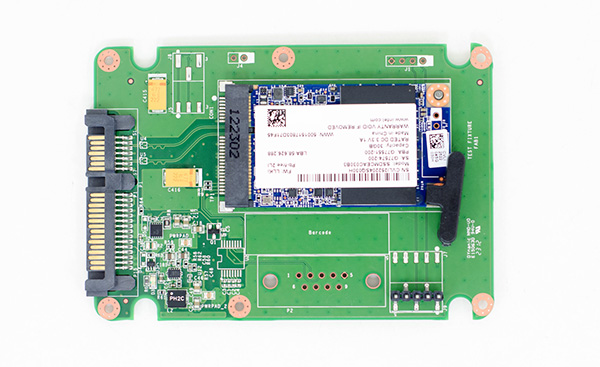The Full Intel SSD 525 Review: 30GB, 60GB, 120GB, 180GB & 240GB Tested
by Anand Lal Shimpi on February 3, 2013 2:30 AM EST- Posted in
- Storage
- SSDs
- Intel
- SandForce
- Intel SSD 520
- Intel SSD 525
Last week we published a teaser look at Intel's latest mSATA SSD: the Intel SSD 525. At the time we only presented performance for a single 240GB drive, however Intel decided to break the mold and send us nearly every capacity in the 525 lineup. We've finally completed testing of the remaining capacities and can now bring you a full look at the Intel SSD 525 lineup.
Typically manufacturers send along their best performing SSD and what follows after launch is a bunch of begging for or outright purchase of additional capacities in order to present the most complete picture. Intel was one of the first companies to send along both large and small capacity SSDs in for review, so it's no surprise that they're one of the first to send nearly every member of a new SSD family for review. I can't stress how important it is that other manufacturers follow in Intel's footsteps here. Given the direct relationship between the number of NAND die/packages on an SSD and the performance of the drive, being able to demonstrate the performance of the entire family is very important to those looking to make an actual buying decision.
In the case of the 525, Intel did a good job of keeping things pretty simple. Since the 525 is exclusively an mSATA drive, there's only room for a maximum of four NAND packages on board. The 525 still uses 25nm 2bpc MLC NAND, which is limited to 8GB of NAND per die and 8 die per package (64GB max per NAND package). This is where the 240GB max capacity comes from (256GB of actual NAND).
With the exception of the 90GB and 180GB drives, all of the 525s populate all four NAND packages. The 90GB and 180GB drives are the exception and only feature three NAND packages on board:

Intel SSD 525 180GB (top) vs. Intel SSD 525 240GB (bottom)
The full breakdown of capacities and NAND split are listed below:
| Intel SSD 525 | |||||||
| Advertised Capacity (GB) | User Addressable Space (GiB) | Total NAND On-board (GiB) | % Spare Area | NAND Packages Number/Die per Package/Package Capacity | MSRP | ||
| 30GB | 27.95 GiB | 32 GiB | 12.6% | 4 / 1 / 8 GiB | $54 | ||
| 60GB | 55.89 GiB | 64 GiB | 12.6% | 4 / 2 / 16 GiB | $104 | ||
| 90GB | 83.82 GiB | 96 GiB | 12.6% | 3 / 4 / 32 GiB | $129 | ||
| 120GB | 111.79 GiB | 128 GiB | 12.6% | 4 / 4 / 32 GiB | $149 | ||
| 180GB | 167.68 GiB | 192 GiB | 12.6% | 3 / 8 / 64 GiB | $214 | ||
| 240GB | 223.57 GiB | 256 GiB | 12.6% | 4 / 8 / 64 GiB | $279 | ||
All of the 525 members feature the same ~12.6% spare area (~14% OP). Despite the reduction in number of NAND packages, the 90 and 180GB models aren't actually any slower than the 60GB and 120GB versions respectively. The reason that performance doesn't suffer when going to these odd sizes is because Intel/SF do a good job of parallelizing requests across all NAND die within a package, of which there are physically more in the 90/180GB configurations compared to the 60/120GB models.

I went over the rest of the details of the 525 in the initial review. In short, the SF-2281 controller is still at use but paired with firmware that's directed/validated by Intel. Performance, compatibility and stability can be different on the 525 compared to other drives that use SandForce's SF-2281 controller. The 525 in particular uses a newer version of the Intel branch of the SF-2281 firmware with additional stability/compatibilty enhancements and power optimizations. The 525's LLKi firmware revision hasn't been backported to the 520/330/335 and as of now there aren't any public plans to do so. The 525 also comes with a 5-year warranty from Intel.

Performance of the 525 is very similar to the 2.5" Intel SSD 520 that came before it, the big difference here is the physical size of the drive as the 525 is mSATA only. For all testing we used an mSATA to SATA adapter:












26 Comments
View All Comments
PolarisOrbit - Monday, February 4, 2013 - link
The comparison table on the first page indicates a 90GB drive and then it's never mentioned again in the rest of the article.Denithor - Monday, February 4, 2013 - link
Addressed in the first paragraph:"At the time we only presented performance for a single 240GB drive, however Intel decided to break the mold and send us nearly every capacity in the 525 lineup."
I would imagine that the 90GB model is the one they didn't provide.
AndrewDobie - Monday, February 4, 2013 - link
Love my job, since I've been bringing in $5600… I sit at home, music playing while I work in front of my new iMac that I got now that I'm making it online.(Click Home information)http://goo.gl/nY29F
philipma1957 - Monday, February 4, 2013 - link
first what mobo can I buy that will run at sata III speeds.I have 3 mobos with msata's all 3 use sata II speed's.
I have an intel h77 itx
an asrock z77 itx
an asus z77 matx
second question when will the crucial m500 480gb drop?
third question which has nothing to do with msata just sata. when does sata IV come out.
I get a bit bored with ssd reviews since speed is pretty much capped at 550 read write.
iops are not going to go to 550 read write at random 4k.
so sata 4 would mean all new speeds to droll over.
a bigger msata like the crucial m500 would be nice.
and an itx board that used msata at sata III would be nice.
not knocking intel but ssd's seem to have become more of the same.
As Jimmy Fallon would say bigger harder faster stronger.
oh one last thing the 5 year warranty is nice.
Kristian Vättö - Monday, February 4, 2013 - link
Crucial M500 is Q2'13, that's all we know for now. I'm very interested in the drive as well, hopefully we can get samples soon.SATA Express is the future of SATA, we likely won't see SATA IV (12Gbps) for a few years (if we'll ever even see it). We may see some SATAe based SSDs/mobos H2'13 but I haven't heard any specific time frame.
DanNeely - Monday, February 4, 2013 - link
That's disappointing; I was hoping they'd be available by 13Q2 to go along with the Haswell launch since there will be an uptick of enthusiast system building then. Based on prior history my Haswell box will last at least until Skylake launches; and probably until the tick following it four years from now.ssj3gohan - Monday, February 4, 2013 - link
... because I just care that much :DBut seriously, Anandtech. Let's talk logic here. Intel has specification sheets with detailed power consumption numbers. It says for the entire SSD 525 series: 250mW idle typical, 300mW under mobilemark 2007.
How can you look at your own power consumption numbers and say 'well, close enough, let's just publish it even though it's 100% too high and clearly not correct'?
Here's how to fix your SSD power consumption errors: measure power consumption going directly into the drive on all rails and use it in a system that has device initiated power management features enabled (DIPM), that is: basically all operating systems nowadays.
Anand Lal Shimpi - Monday, February 4, 2013 - link
As I mentioned in the review, the mSATA adapter we test with only supplies 5V to the drive. To address this going forward I need to modify a board with a native mSATA connector and measure 3.3V on the board itself. The results here at least allow you to compare the various capacities of the 525.MobileMark 2007 is mostly an idle test, which is why none of our loaded numbers have ever come close to any spec sheet that reports it. This is the same reason we don't use it in our notebook reviews.
We will be switching to DIPM-only testing in our 2013 storage suite update, which will unfortunately break backwards comparability with our older results.
Take care,
Anand
RU482 - Monday, February 4, 2013 - link
Anand,What mSATA adapter board are you using?
Just a thought, you should be able to lift a lead on the 5-to-3.3V regulator on the board and measure the output current with a multi-meter.
extide - Monday, February 4, 2013 - link
Also note that those mSATA to SATA converters use a little linear regulator(like a 7833) to convert the 5v to 3.3v. Linear regulators are very in-efficient, as they essentially turn the "extra" voltage into heat by using a network of resistors.If you are simply measuring the power into the adapter then you are not getting a very good look at the actually mSATA device power draw.
HOWEVER, if someone else is using the adapter in their system they will also be utilizing that same linear regulator, and thus see the same power usage as they show in the article here.